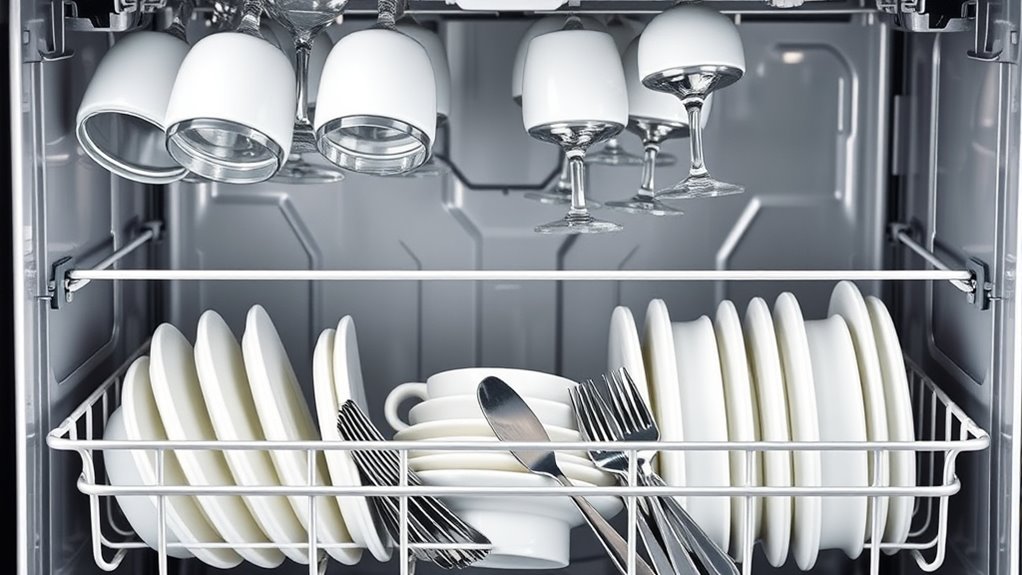To get sparkling dishes, load your dishwasher properly by placing larger items like pots and plates along the sides and back for water flow. Make certain glasses and small items go on the upper rack at an angle, and keep dishes spaced apart for thorough cleaning. Always face dirty sides toward water jets and avoid overcrowding, which can block spray arms. Proper placement boosts water circulation and cleaning results—keep exploring to learn even more tips for perfect loads.
Key Takeaways
- Arrange larger items along sides and back to ensure water flow reaches all surfaces.
- Load glasses and plastics on the upper rack at an angle to prevent pooling and spots.
- Place dirty sides of dishes facing water jets and ensure proper spacing for thorough cleaning.
- Avoid overcrowding to allow water and detergent to circulate freely around all items.
- Group utensils properly and handle delicate items carefully to prevent damage and ensure sparkling results.

Loading your dishwasher correctly guarantees everything gets clean and lasts longer. Properly arranging your dishes is essential to ensure ideal water circulation, which directly impacts the cleanliness of your load. When dishes are loaded haphazardly, water can’t reach all surfaces effectively, leading to streaks and spots. To maximize water circulation, position larger items like pots, pans, and plates along the sides and back of the dishwasher, allowing water jets to flow freely around them. Place glasses and smaller items on the upper rack, angling them slightly to prevent water from pooling inside. This setup helps water move evenly over every item, preventing leftover residue and improving overall cleaning performance.
Another critical aspect of loading is guaranteeing detergent effectiveness. When dishes are overcrowded or stacked too tightly, detergent tablets or powder can’t dissolve properly, reducing their ability to break down grease and grime. To promote effective cleaning, avoid blocking the spray arms or jamming them with utensils or large items. Leave enough space between dishes so water and detergent can circulate freely around each piece. Proper spacing also allows hot water and detergent to contact all surfaces, ensuring thorough cleaning and reducing the need for pre-rinsing. Additionally, always load dishwasher-safe items according to manufacturer instructions, especially for delicate glassware and plastics, which may require specific placement to prevent damage or water spots.
It’s equally important to load dishes with their dirty sides facing the water jets. For example, plates should be positioned so that the dirtiest surfaces face the center or spray arms, ensuring they get the full force of the water pressure. Utensils should be placed with handles down to prevent nesting and to expose their cleaning surfaces. Silverware baskets should be loaded with similar utensils grouped together, with utensils that tend to trap food positioned so water can reach them. Avoid overlapping dishes or stacking them too tightly, as this can trap food particles, hinder water flow, and diminish detergent effectiveness. Properly loading patterns ensure optimal water flow and cleaning results. When you load your dishwasher thoughtfully, you’re not just saving time and energy—you’re also ensuring each dish comes out spotless and streak-free.
Frequently Asked Questions
Can I Load Plastic Utensils on the Top Rack?
Yes, you can load plastic utensils on the top rack of your dishwasher. The top rack is ideal because it keeps plastic utensils away from the heating element, preventing warping or melting. Make sure the plastic utensils are dishwasher-safe and place them with their handles down for thorough cleaning. This way, you’ll achieve sparkling results without risking damage to your plastic utensils.
How Do I Prevent Glasses From Cloudy Spots?
Think of your glasses as tiny crystal balls, and you want them shining bright. To prevent cloudy spots, use a rinse aid and opt for a dishwasher with a heated dry cycle. Regularly check for mineral deposits, which can leave your glasses looking foggy. Also, avoid overloading, so water circulates freely. These steps help maintain glass clarity and keep your sparkling glasses crystal clear every time.
Should I Rinse Dishes Before Loading?
You don’t need to pre-rinse dishes before loading, as most dishwashers handle light residue well with a proper dishwasher pre wash cycle. However, for heavily soiled items, a quick rinse can help prevent food from sticking and improve cleaning results. Check your dishwasher’s manual to see if pre-rinse is recommended, but generally, a quick rinse isn’t necessary unless dishes are very dirty.
How Often Should I Clean the Dishwasher Filters?
You should clean your dishwasher filters at least once a month to maintain ideal performance. Regular filter maintenance prevents food debris and grease buildup, which can cause poor cleaning results. If you notice your dishes aren’t sparkling or the dishwasher smells, increase cleaning frequency. Removing and rinsing the filters with warm water and a soft brush helps keep your dishwasher running efficiently and guarantees your dishes come out spotless every time.
Is It Okay to Overload the Dishwasher?
You might think overloading your dishwasher saves time, but it actually risks improper spacing, which can prevent dishes from cleaning properly. Overloading risks blocking spray arms and causing water to stagnate, leaving dishes dirty or streaked. To guarantee sparkling results, load dishes with enough space between them, allowing water and detergent to circulate freely. This way, you avoid damage and get the best cleaning performance every time.
Conclusion
By following these proper loading techniques, you’ll guarantee your dishes come out sparkling every time. Remember, a well-loaded dishwasher is like a well-tuned engine—everything works better. Don’t forget to load items with care, avoiding overcrowding, and always follow manufacturer instructions. When you treat your dishwasher right, it treats your dishes even better. As the saying goes, “A stitch in time saves nine”—taking a moment to load correctly now saves you time and effort later.









